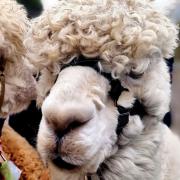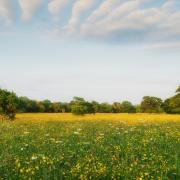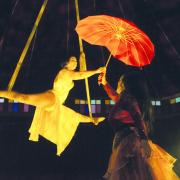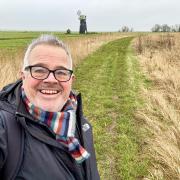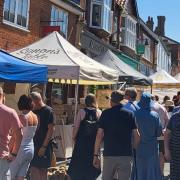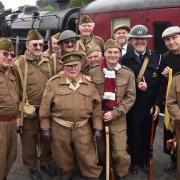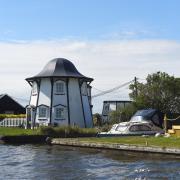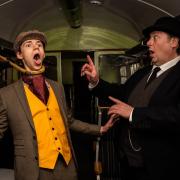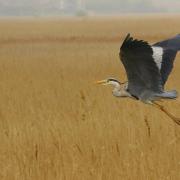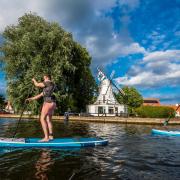Our visitor centres are inspirational treasures, says Norfolk Wildlife Trust ambassador Nick Acheson
As a boy I often cycled from my home in Little Snoring to Cley Marshes (on the same red bicycle my mother bought in 1979, which I still ride to this day).
Reaching Cley – and it astonishes me now that I would even think to do this – I would cycle up the steep concrete ramp to the black-stained, wooden Dick Bagnall-Oakeley Visitor Centre.
Dick was my father’s geography teacher at Gresham’s School in Holt in the 1950s. A celebrated raconteur, he was a fount of stories on Norfolk, nature and countless other subjects. My father (now 81) blames the ease with which Dick could be diverted onto any fascinating but irrelevant tangent for his failure at O level geography.
Passionate about birds, Dick Bagnall-Oakeley made numerous films at Cley, some of which were broadcast by Survival. He also regularly brought boys from Gresham’s to the marsh, inspiring in them a love of birds and wildlife. So, when in 1981 Norfolk Wildlife Trust raised money to build Cley’s first Visitor Centre, it was natural that it should be named after Dick.
As a youngster, the DBO (as it came to be known) was a place of excitement for me. It was my doorway to the marsh, where my keen young mind was learning the names and habits of wild things. I vividly remember the photos on the wall of near-mythical birds which had been seen on the marsh and of the whiskery men who had founded Norfolk Naturalists Trust in 1926 and handed this miraculous place into its care.
Our facilities at Cley are very different today, though the DBO still welcomes exhibitions of photography and art. The view from our glass-fronted Visitor Centre is unparalleled in Norfolk and among the finest on any UK nature reserve. Here, with a mug of coffee or a warming bowl of soup, a visitor can sit for hours and watch as dark-bellied brent geese fly in burbling waves to the scrapes; or as spoonbills chase after sticklebacks, their outlandish crests waving in the spring breeze.

Cley Marshes is a place of learning and of sharing too. Year-round we host talks, workshops and events in the Simon Aspinall Wildlife Education Centre. If you can tear your eyes for an hour from the crashing waves and the languid flight of marsh harriers, you can learn to draw or identify moths, you can chat with authors or listen with your children or grandchildren to tales of the wind and the wild.
Indeed all our Visitor Centres are places of learning and of fun. From the Broads Wildlife Centre you can board our electric boat and visit Ranworth Broad. Here you will learn about the common terns which fly from West Africa every spring to nest on the floating platforms we have built for them. The edges of the platforms have heavy rubber curtains, to keep the otters off. Otters declined catastrophically in the UK in the twentieth century, poisoned by agricultural chemicals which are happily now banned. They have returned to the Broads in force, and Ranworth is among the finest sites for seeing them. This is a place of swallowtail butterflies too, and their caterpillars, which munch on milk parsley in the rich fen by the Broads Wildlife Centre.
Not far away, at Hickling Broad, our Visitor Centre is your stepping stone into one of the county’s most precious landscapes for wildlife. There are swallowtails here too of course, flapping like scribbled scraps of tissue paper above the reed. And there are boat trips, taking you to quiet corners of the broad, into a world of bearded tits and bitterns. But Hickling’s Visitor Centre offers so much more.
All through the Easter and summer holidays you will find our outreach team at Hickling, pond-dipping with children, teaching them the secrets of the reedbeds, and sharing the lives of our family of konik ponies. As at all our visitor centres, there are hot and cold drinks and food for sale, and sunny spots outside to sit while you eat, listening to the songs of cuckoos and blackcaps and the joyous bugling of common cranes from the distant marsh.

At our Visitor Centre at Weeting Heath, in Breckland, you may hear the wail of stone curlews instead (though cranes do breed nearby). The soulful burble of common curlews and the breathy sci-fi tumbling of lapwings are heard here too, as all three species nest on the priceless grassland of the reserve. Even Weeting’s car park is alive with life. Woodlarks are often heard here, piercing the Breckland sky with their heartbreaking song, while at your feet is a tiny world of brown argus butterflies, mottled grasshoppers and pantaloon bees. In the shade at the edge of the car park, under tall pines and gnarled old buckthorn bushes, the shy blooms of broad-leaved helleborines may be seen.
Our last Visitor Centre is the wildest, the most remote, the hardest to define. At the end of a long sandy track, with dune slacks to the north, grazed by konik ponies for the benefit of natterjack toads, and grazing marshes to the south – loud with the Arctic whistles of wigeon or the insistent chimes of nesting avocets – you find The Firs, headquarters of our Holme Dunes reserve. This is a wondrous place, with saltmarsh, reedbed, pioneer dune, freshwater scrape and pine woodland, all waiting to be explored. Happily, as at all our Visitor Centres, you can buy a range of books here, to help you understand the wealth of wildlife you may see.
Our Visitor Centres are treasures. Windows onto our reserves, they are an invitation to visit the precious habitats we protect. Run by friendly staff and an army of invaluable volunteers, they share the best of Norfolk’s wildlife with our visitors and members. And every penny spent in them supports the critically important work we do right across the county, for people, for biodiversity and for our environment.
Find out more at norfolkwildlifetrust.org.uk




